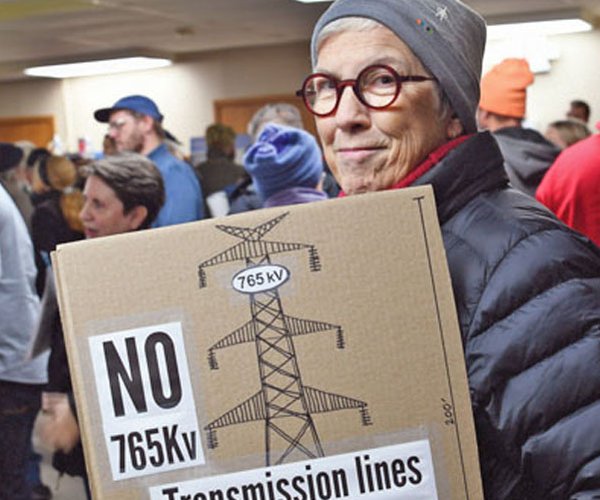League of Women Voters (LWV) of the Upper Mississippi River Region (UMRR) held an informational webinar on the topic of Clean Water Implementation after the U.S. Supreme Court’s (SCOTUS) ‘Sackett’ decision. Speakers from LWV and Midwest Environmental Advocates (MEA) detailed the history of state and federal regulation of wetlands on Monday, Nov. 6.
MEA’s staff attorney Rob Lee pointed out that the new rule, written jointly by the Environmental Protection Agency (EPA) and the U.S. Army Corps of Engineers (USACE) after the SCOTUS decision will reduce federal jurisdiction over wetlands, especially in the Upper Midwest.
“After the Sackett decision and the release of this new rule, if there are no protections in place at the state level for wetlands, then we could begin to see more water quality problems, and be deprived of the many ecosystem services that wetlands provide,” Lee said. “It is crucial that we do everything possible to maintain what we have.”
According to Wisconsin DNR, Wisconsin's wetlands are important to the ecology and economy of the state, but are also an imperiled resource. Nearly half of the 10 million acres present in the 1800s have been destroyed, drained or filled to make way for agriculture, roads, cities and other uses.
History of rule
The federal Clean Water Act (CWA) was passed by the U.S. Congress in 1972. Section 404 requires a permit from USACE to discharge dredged runoff or fill material into navigable waters. It also authorizes states to administer their own program instead of the Corps – a provision known as ‘cooperative federalism.’
“Of the 52 states, 47 delegate responsibility to the federal government,” Lee said. “Only Michigan, New Jersey and Florida have taken responsibility for administering their own Section 404 program.”
The authority of the CWA comes from the Interstate Commerce clause of the U.S. Constitution, and this is also where the term ‘Waters of the United States’ (WOTUS) language comes from.
WOTUS is referenced in the CWA, but not defined there. The definition as set forth in Article 1, Section 8, Clause 3 of the U.S. Constitution defines WOTUS as “Interstate waters that are navigable in fact or readily susceptible of being navigable in fact.”
Under the Longshore Act, the definition of navigable waters is taken from the case of The Daniel Ball (1871), in which the U.S. Supreme Court stated:
"(Rivers) are navigable in fact, when they are used, or susceptible of being used, in their ordinary condition, as highways of commerce, over which trade and travel are or may be conducted … and they constitute navigable waters of the United States, in contradistinction from the navigable waters of the State, when they form in their ordinary condition by themselves, or by uniting other waters, a continued highway over which commerce is or may be carried on with other states or foreign countries."
“The problem is that referencing ‘navigable waters’ in the CWA leaves other types of water features unconsidered,” Lee explained. “Those are features like tributaries to traditional navigable waters, ephemeral streams, adjacent wetlands, interstate wetlands, and isolated non-navigable intrastate waters and wetlands.”
There were a couple of court cases that continued to flesh out the water features that enjoyed protection under the Clean Water Act. Those were Riverside Bayview (1985), and SWANCC (2001).
Riverside Bayview held that a wetland that actually abuts on a navigable waterway is WOTUS. It recognized the difficulty in determining the exact line of demarcation between water and solid land, with wetlands often in between; and recognized the ecological connection between wetlands and surface waters, and that it is reasonable for USACE to interpret WOTUS as including some wetlands to help achieve Congress’ water quality goals in the CWA.
The SWANCC case held that the CWA does not extend to ponds that are not adjacent to open water. Thus, the Migratory Bird Rule, which applied CWA protections to any waters or wetlands that are or would be used as habitat by migratory birds or endangered species, could not extend jurisdiction to isolated intrastate waters; and clarified that the ‘significant nexus’ between the wetlands and navigable waters informed the Riverside Bayfield decision.
“This was the first time that the ‘significant nexus’ language was used in a court decision,” Lee said.
Then, in 2006, in the Rapanos v. United States case, the question was raised whether a wetland may be considered ‘adjacent to’ remote WOTUS because of a mere hydrologic connection to them.
The Supreme Court ruled ‘no’ to this question, with Justice Scalia writing the plurality opinion where he laid out the ‘continuous surface connection’ test. He wrote in his opinion:
“[O]nly those wetlands with a continuous surface connection to bodies of water that are [WOTUS] in their own right, so that there is no clear demarcation between ‘waters’ and wetlands, are ‘adjacent to’ such waters and covered by the [CWA]. Wetlands with only an intermittent, physically remote hydrologic connection to [WOTUS] do not implicate the boundary-drawing problem of Riverside Bayview, and thus lack the necessary connection to covered waters that we described as a ‘significant nexus’ in SWANCC.”
Justice Kennedy wrote a concurrence to the Rapanos opinion, supporting the ‘significant nexus’ test. That concurrence stated that when wetlands have a significant nexus to WOTUS, they are covered under the CWA. That concurrence stated:
“[W]etlands possess the requisite nexus, and thus come within the statutory phrase ‘navigable waters,’ if the wetlands, either alone or in combination with similarly situated lands in the region, significantly affect the chemical, physical and biological integrity of those waters. When, in contrast, wetlands effects on water quality are speculative or insubstantial, they fall outside the zone fairly encompassed by the term ‘navigable waters’.”
“This decision basically left us with competing tests – ‘significant nexus’ and ‘significant surface connection,’ and said that if it meets either standard, it is legal,” Lee told the group.
Recent revisions
In 2015, President Obama’s administration implemented a rule that incorporated Justice Kennedy’s ‘significant nexus’ standard to administer the CWA. They were immediately sued in 27 states within two days of announcing the new rule, and the Supreme Court put national implementation of the rule on hold while it moved through the courts.
In 2017, President Trump’s administration announced their intent to revise the rule, and in 2020, the rule was repealed and replaced with the Navigable Waters Protection Rule (NWPR) that incorporated the ‘continuous surface connection’ standard.
“The new rule includes abutting wetlands and wetlands that are separated from WOTUS by natural berms, banks, dunes, etc., and artificial structures that are permeable such as dikes or roads,” Lee said. “Wetlands under this rule were not included when separated by artificial barriers that sever hydrologic connections, and wetlands further away are not included even if there is a hydrologic connection.”
Lee explained that after release of the rule, 17 states, ranchers, and environmental organizations sued over the next three months. The NWPR was vacated by an Arizona federal district court in 2021. At this point, EPA and USACE reverted back to the pre-2015 interpretations until the Biden Administration released another WOTUS rule in late 2022. That rule was enjoined in 27 states when the Supreme Court’s Sackett decision was released.
Sackett decision
In 2023, the U.S. Supreme Court ruled in the Sackett v. EPA case. The Sacketts purchased a property in Bonner County, Idaho, and began backfilling to build a home, including filling of wetlands. EPA used the ‘significant nexus’ approach to determine those wetlands were ‘adjacent’ to an unnamed tributary, on the other side of a 30-foot road, which in turn feeds into Priest Lake, andintrastate yet traditionally navigable water of the U.S.
Lee explained that to establish ‘significant nexus,’ EPA lumped the Sackett’s lot together with the Kalispell Bay Fen, a large nearby wetland complex that [EPA] regarded as ‘similarly situated.’ According to EPA, these properties, taken together, ‘significantly affected the ecology of Priest Lake.
“The major question in Sackett was what is the proper test for determining whether wetlands are adjacent to a WOTUS?” Lee explained. “The Court adopted Scalia’s plurality opinion from Rapanos upholding the continuous surface connection test, and ruled that the CWA only extends to those wetlands that are adjacent to a body of water that constitutes WOTUS (a relatively permanent body of water connected to traditional interstate navigable waters); and have a continuous surface connection with that water, making it difficult to determine where the water ends and the wetland begins.”
Lee explained that the Sackett decision:
• removed the ‘significant nexus’ test as a standard for all WOTUS
• revises the ‘adjacency’ definition to conform with the ‘continuous surface connection’ test
• removed ‘interstate wetlands’ from WOTUS.
Lee further explained that under the revised WOTUS definition:
• traditional navigable waters are in
• tributaries to traditional navigable waters are in if there is a continuous surface connection to a traditional navigable waters
• ephemeral streams are out if they only flow in response to precipitation, and must be “relatively permanent”
• interstate wetlands are out unless they qualify as an adjacent wetland
• isolated, non-navigable intrastate waters and wetlands are out.
“After Sackett, EPA and USACE came out with a joint rule to implement the CWA where they removed interstate wetlands,” Lee said. “There haven’t been any lawsuits challenging the decision yet, and the new rule is only six pages long as compared to the old rules which were 100s and 1,000s of pages long.”
What’s next?
Gretchen Sable of LWV posed the question for webinar participants, “What’s next?” She explained that the impact of the Sackett decision will vary by state whereas the CWA is a national law.
“In the humid climate of the UMRR, there will be fewer ephemeral streams, with many acres of wetlands already lost,” Sable said. “In the five states that comprise the UMRR, there were 45 million acres of wetland in the pre-settlement period, and 2014 data shows just 18 million left.”
Specifically, the data shows the following:
• Illinois: 85 percent of the original 8,212,000 acres of wetlands lost
• Iowa: 89 percent of the original 4,000,000 acres of wetlands lost
• Minnesota: 43 percent of the original 18,583,000 acres of wetlands lost
• Missouri: 87 percent of the original 4,844,000 acres of wetlands lost
• Wisconsin: 47 percent of the original 10,000 acres of wetlands lost.
“Of those states, Iowa and Missouri are reliant on the federal definition of WOTUS,” Sable said. “Illinois has limited state coverage of water features not included in the definition of WOTUS, and Wisconsin and Minnesota have broad coverage of those features.”
Long LWV history
Sable pointed out that LWV has a long history of advocacy on the Clean Water Act. The League’s citizen activists help pass the CWA in 1972, and worked to protect, expand and strengthen it through the 1990s.
“Water issues, from groundwater to agricultural runoff to the Safe Drinking Water Act have energized League leaders, especially at the local level, for decades,” Sable said.
Our positions on water are as follows:
• water resource programs and policies that reflect the interrelationships of water quality, water quantity, groundwater, and surface water, and that address the potential depletion or pollution of the water supplies
• measures to reduce water pollution from direct point-source discharges and from indirect nonpoint sources
• policies to achieve water quality essential for maintaining species populations and diversity, including measures to protect lakes, estuaries, wetlands and in-stream flows
• stringent controls to protect the quality of current and potential drinking water supplies, including protection of watersheds for surface supplies and of recharge areas for groundwater.
Sable said that new federal CWA legislation has been introduced that would “undo the damage of the Supreme Court’s misguided Sackett decision by reinstating the historic and bipartisan federal-state partnership that has protected our waters for over 50 years.”
New CWA legislation
Called the ‘Clean Water Act of 2023,’ the bill would change use of the words ‘navigable waters’ to ‘protected water resources.’ The term ‘protected water resources’ means all waters subject to the ebb and flow of the tide, the territorial seas, and all interstate and intrastate waters (and their tributaries), including lakes, rivers, streams (including intermittent and ephemeral streams), wetlands, and all impoundments of the foregoing, to the fullest extent that these waters are subject to the legislative power of Congress under the Constitution.
The term ‘wetlands’ means those areas that are inundated or saturated by surface or ground water at a frequency and duration sufficient to support, and that under normal circumstances do support, a prevalence of vegetation typically adapted for life in saturated soil conditions.





